An Analysis of Toyota's Environmental Practices and Recommendations
VerifiedAdded on 2022/12/22
|10
|2256
|84
Report
AI Summary
This report, addressed to Toyota Motor Corporation (TMC), examines the company's environmental practices and business ethics. It begins with an introduction to environmental concerns and the significance of corporate responsibility. The report provides a company background, details past and present business practices and policies, and analyzes Toyota's positive and negative actions regarding environmental pollution. Recommendations are made for improving environmental performance, including promoting environmental education, reducing harmful substances, and supporting conservation efforts. The report considers the benefits, challenges, and implications of these recommendations for key stakeholders, including customers, shareholders, business partners, local communities, and employees. The conclusion summarizes the findings and emphasizes the importance of Toyota's commitment to environmental sustainability. References are included to support the analysis and recommendations.
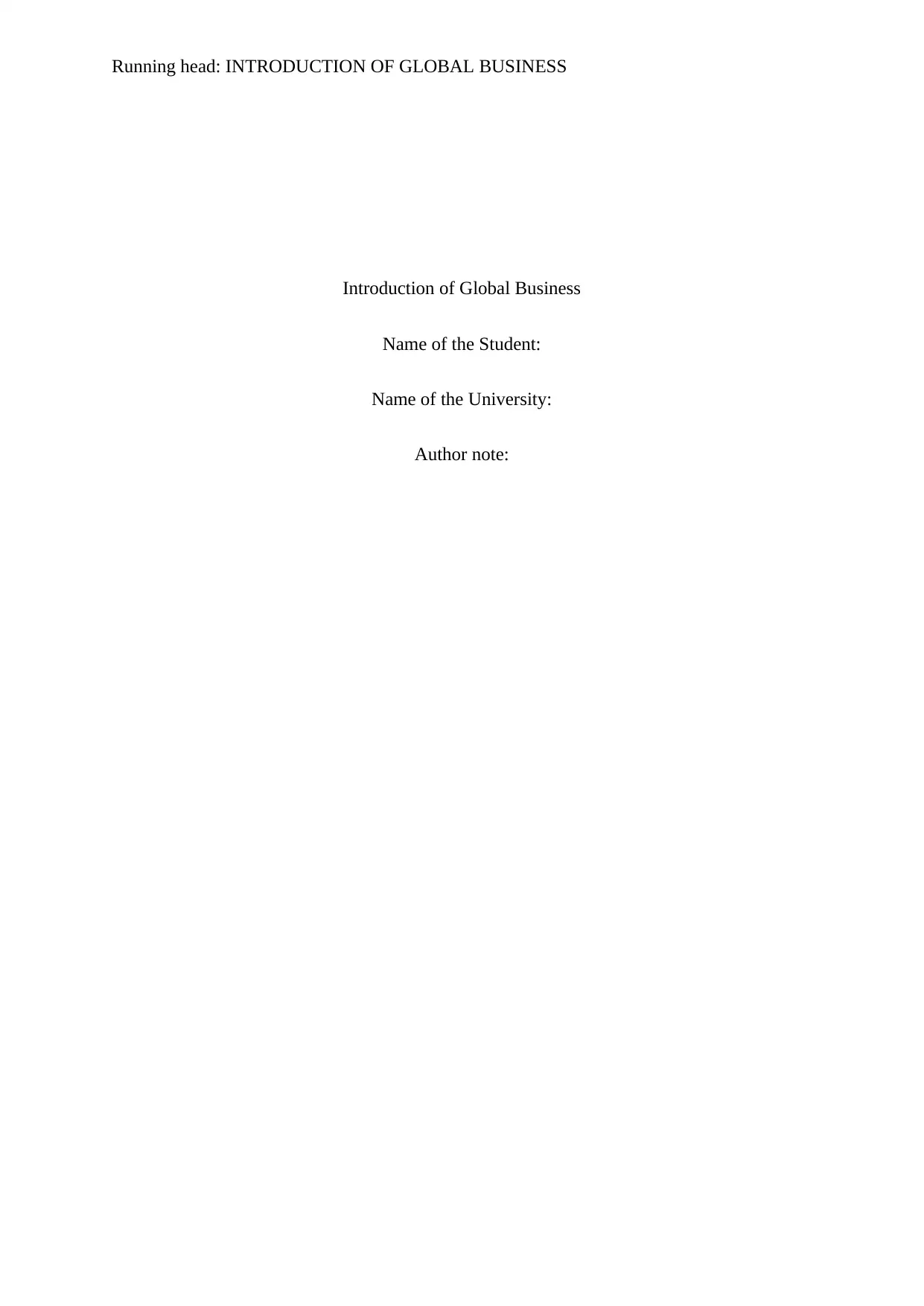
Running head: INTRODUCTION OF GLOBAL BUSINESS
Introduction of Global Business
Name of the Student:
Name of the University:
Author note:
Introduction of Global Business
Name of the Student:
Name of the University:
Author note:
Paraphrase This Document
Need a fresh take? Get an instant paraphrase of this document with our AI Paraphraser
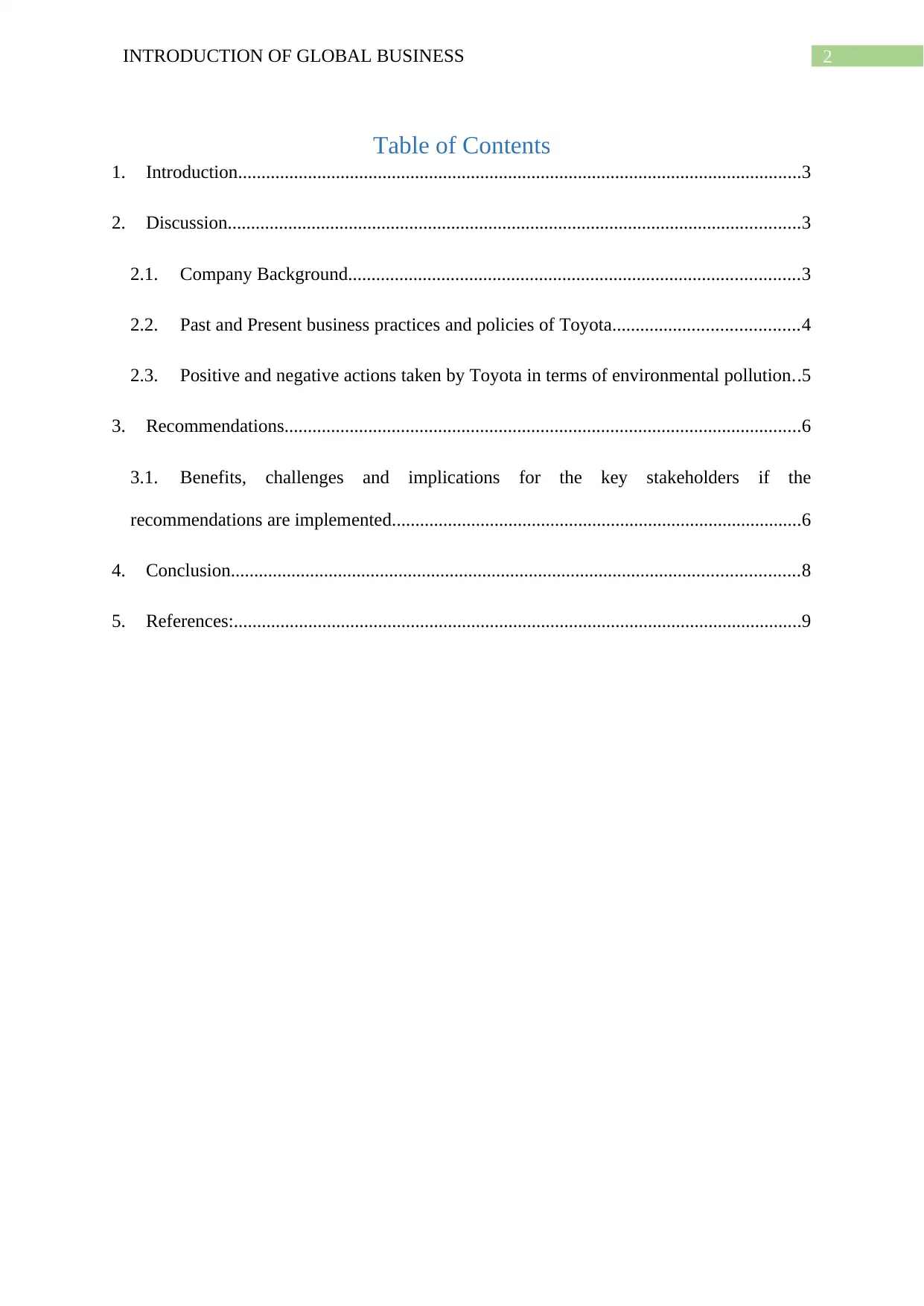
2INTRODUCTION OF GLOBAL BUSINESS
Table of Contents
1. Introduction.........................................................................................................................3
2. Discussion...........................................................................................................................3
2.1. Company Background.................................................................................................3
2.2. Past and Present business practices and policies of Toyota........................................4
2.3. Positive and negative actions taken by Toyota in terms of environmental pollution..5
3. Recommendations...............................................................................................................6
3.1. Benefits, challenges and implications for the key stakeholders if the
recommendations are implemented........................................................................................6
4. Conclusion..........................................................................................................................8
5. References:..........................................................................................................................9
Table of Contents
1. Introduction.........................................................................................................................3
2. Discussion...........................................................................................................................3
2.1. Company Background.................................................................................................3
2.2. Past and Present business practices and policies of Toyota........................................4
2.3. Positive and negative actions taken by Toyota in terms of environmental pollution..5
3. Recommendations...............................................................................................................6
3.1. Benefits, challenges and implications for the key stakeholders if the
recommendations are implemented........................................................................................6
4. Conclusion..........................................................................................................................8
5. References:..........................................................................................................................9
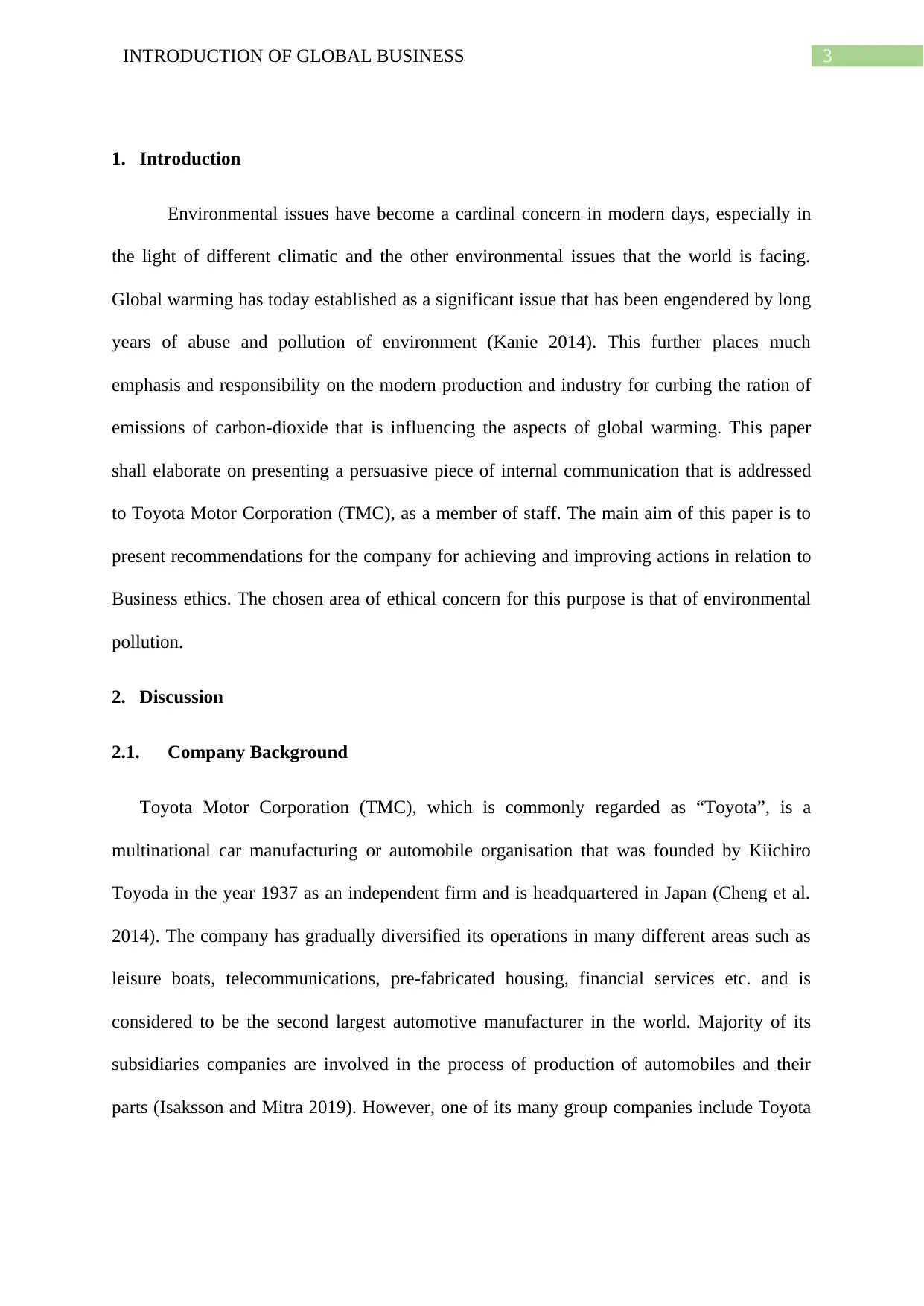
3INTRODUCTION OF GLOBAL BUSINESS
1. Introduction
Environmental issues have become a cardinal concern in modern days, especially in
the light of different climatic and the other environmental issues that the world is facing.
Global warming has today established as a significant issue that has been engendered by long
years of abuse and pollution of environment (Kanie 2014). This further places much
emphasis and responsibility on the modern production and industry for curbing the ration of
emissions of carbon-dioxide that is influencing the aspects of global warming. This paper
shall elaborate on presenting a persuasive piece of internal communication that is addressed
to Toyota Motor Corporation (TMC), as a member of staff. The main aim of this paper is to
present recommendations for the company for achieving and improving actions in relation to
Business ethics. The chosen area of ethical concern for this purpose is that of environmental
pollution.
2. Discussion
2.1. Company Background
Toyota Motor Corporation (TMC), which is commonly regarded as “Toyota”, is a
multinational car manufacturing or automobile organisation that was founded by Kiichiro
Toyoda in the year 1937 as an independent firm and is headquartered in Japan (Cheng et al.
2014). The company has gradually diversified its operations in many different areas such as
leisure boats, telecommunications, pre-fabricated housing, financial services etc. and is
considered to be the second largest automotive manufacturer in the world. Majority of its
subsidiaries companies are involved in the process of production of automobiles and their
parts (Isaksson and Mitra 2019). However, one of its many group companies include Toyota
1. Introduction
Environmental issues have become a cardinal concern in modern days, especially in
the light of different climatic and the other environmental issues that the world is facing.
Global warming has today established as a significant issue that has been engendered by long
years of abuse and pollution of environment (Kanie 2014). This further places much
emphasis and responsibility on the modern production and industry for curbing the ration of
emissions of carbon-dioxide that is influencing the aspects of global warming. This paper
shall elaborate on presenting a persuasive piece of internal communication that is addressed
to Toyota Motor Corporation (TMC), as a member of staff. The main aim of this paper is to
present recommendations for the company for achieving and improving actions in relation to
Business ethics. The chosen area of ethical concern for this purpose is that of environmental
pollution.
2. Discussion
2.1. Company Background
Toyota Motor Corporation (TMC), which is commonly regarded as “Toyota”, is a
multinational car manufacturing or automobile organisation that was founded by Kiichiro
Toyoda in the year 1937 as an independent firm and is headquartered in Japan (Cheng et al.
2014). The company has gradually diversified its operations in many different areas such as
leisure boats, telecommunications, pre-fabricated housing, financial services etc. and is
considered to be the second largest automotive manufacturer in the world. Majority of its
subsidiaries companies are involved in the process of production of automobiles and their
parts (Isaksson and Mitra 2019). However, one of its many group companies include Toyota
⊘ This is a preview!⊘
Do you want full access?
Subscribe today to unlock all pages.

Trusted by 1+ million students worldwide
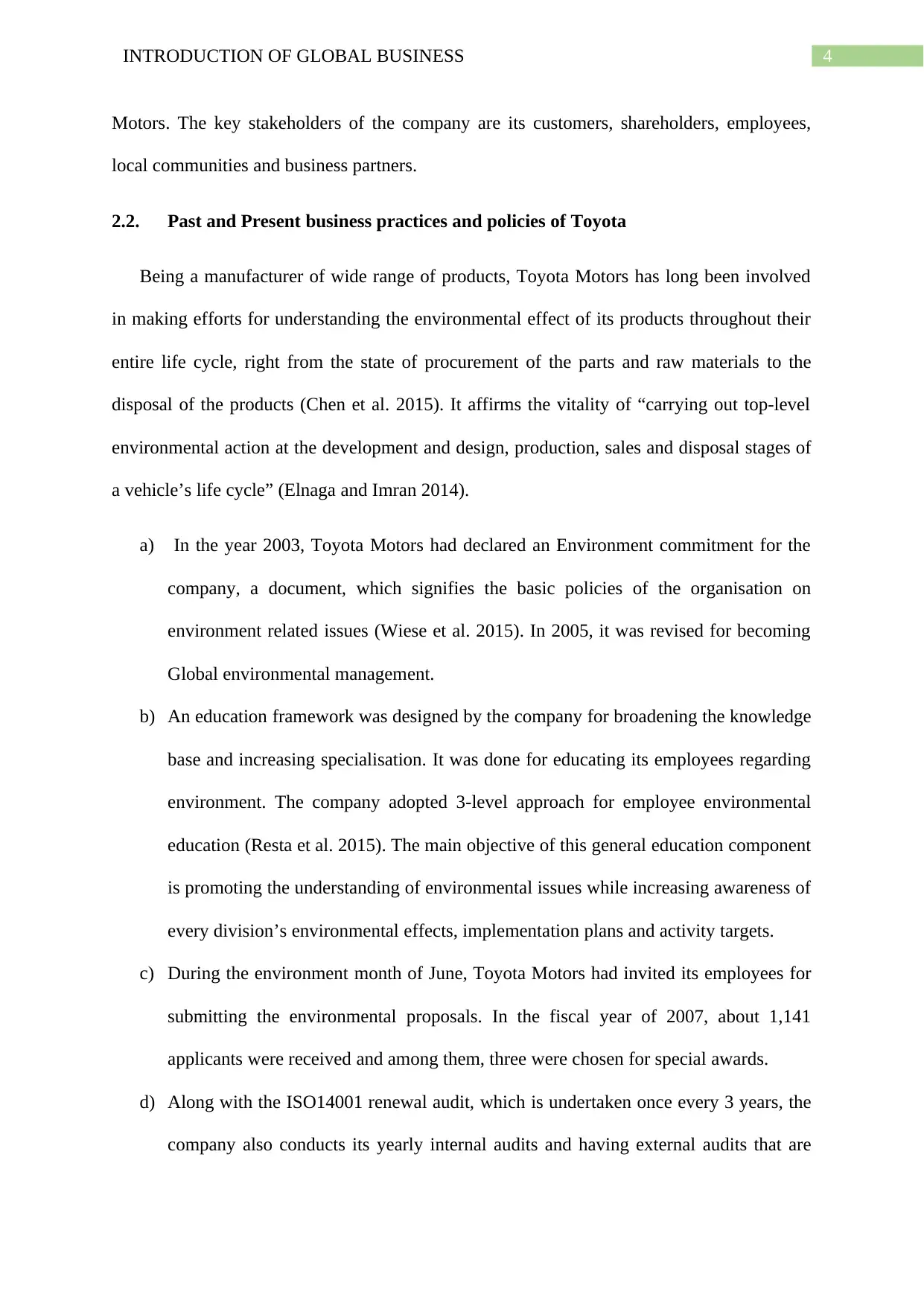
4INTRODUCTION OF GLOBAL BUSINESS
Motors. The key stakeholders of the company are its customers, shareholders, employees,
local communities and business partners.
2.2. Past and Present business practices and policies of Toyota
Being a manufacturer of wide range of products, Toyota Motors has long been involved
in making efforts for understanding the environmental effect of its products throughout their
entire life cycle, right from the state of procurement of the parts and raw materials to the
disposal of the products (Chen et al. 2015). It affirms the vitality of “carrying out top-level
environmental action at the development and design, production, sales and disposal stages of
a vehicle’s life cycle” (Elnaga and Imran 2014).
a) In the year 2003, Toyota Motors had declared an Environment commitment for the
company, a document, which signifies the basic policies of the organisation on
environment related issues (Wiese et al. 2015). In 2005, it was revised for becoming
Global environmental management.
b) An education framework was designed by the company for broadening the knowledge
base and increasing specialisation. It was done for educating its employees regarding
environment. The company adopted 3-level approach for employee environmental
education (Resta et al. 2015). The main objective of this general education component
is promoting the understanding of environmental issues while increasing awareness of
every division’s environmental effects, implementation plans and activity targets.
c) During the environment month of June, Toyota Motors had invited its employees for
submitting the environmental proposals. In the fiscal year of 2007, about 1,141
applicants were received and among them, three were chosen for special awards.
d) Along with the ISO14001 renewal audit, which is undertaken once every 3 years, the
company also conducts its yearly internal audits and having external audits that are
Motors. The key stakeholders of the company are its customers, shareholders, employees,
local communities and business partners.
2.2. Past and Present business practices and policies of Toyota
Being a manufacturer of wide range of products, Toyota Motors has long been involved
in making efforts for understanding the environmental effect of its products throughout their
entire life cycle, right from the state of procurement of the parts and raw materials to the
disposal of the products (Chen et al. 2015). It affirms the vitality of “carrying out top-level
environmental action at the development and design, production, sales and disposal stages of
a vehicle’s life cycle” (Elnaga and Imran 2014).
a) In the year 2003, Toyota Motors had declared an Environment commitment for the
company, a document, which signifies the basic policies of the organisation on
environment related issues (Wiese et al. 2015). In 2005, it was revised for becoming
Global environmental management.
b) An education framework was designed by the company for broadening the knowledge
base and increasing specialisation. It was done for educating its employees regarding
environment. The company adopted 3-level approach for employee environmental
education (Resta et al. 2015). The main objective of this general education component
is promoting the understanding of environmental issues while increasing awareness of
every division’s environmental effects, implementation plans and activity targets.
c) During the environment month of June, Toyota Motors had invited its employees for
submitting the environmental proposals. In the fiscal year of 2007, about 1,141
applicants were received and among them, three were chosen for special awards.
d) Along with the ISO14001 renewal audit, which is undertaken once every 3 years, the
company also conducts its yearly internal audits and having external audits that are
Paraphrase This Document
Need a fresh take? Get an instant paraphrase of this document with our AI Paraphraser
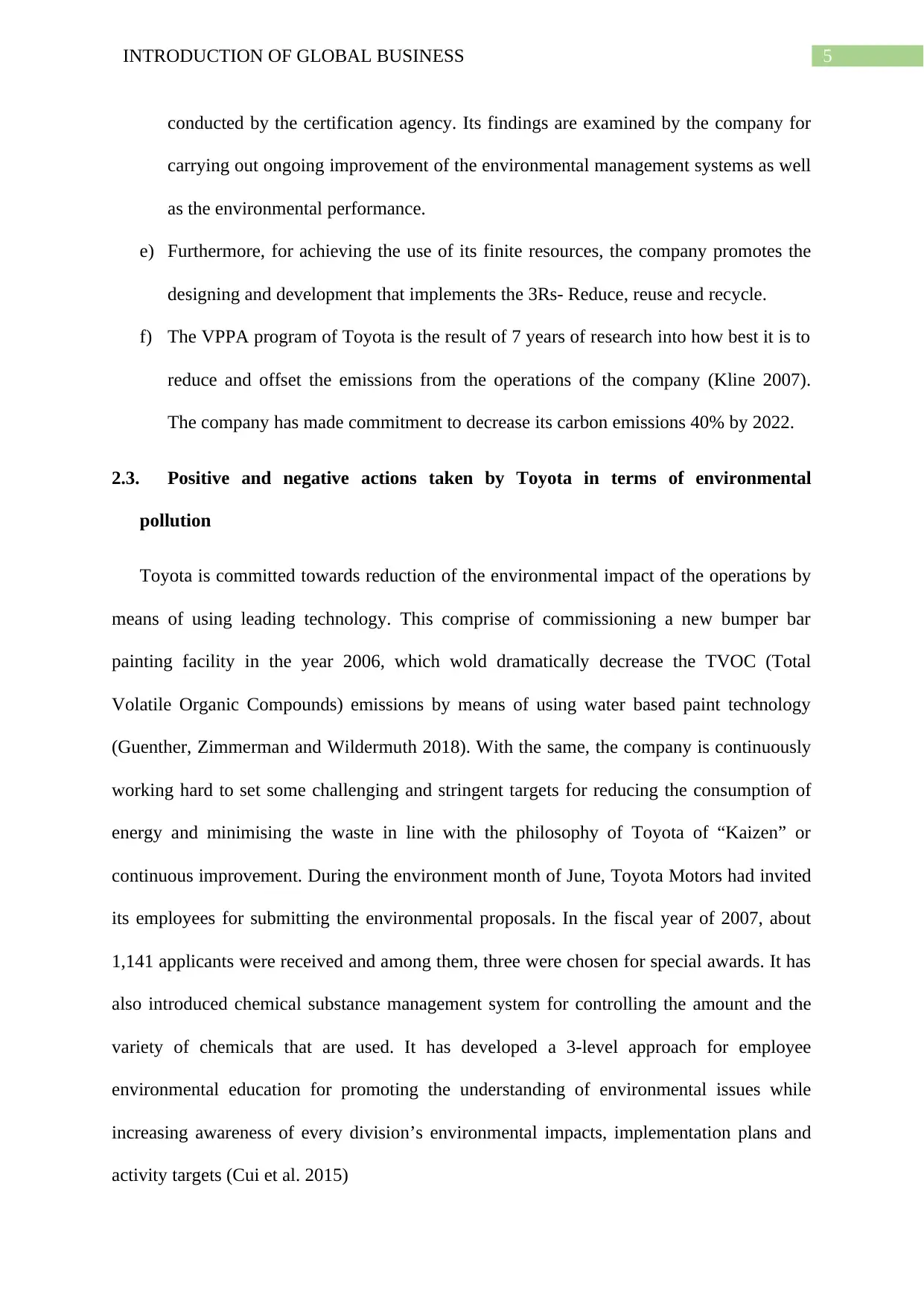
5INTRODUCTION OF GLOBAL BUSINESS
conducted by the certification agency. Its findings are examined by the company for
carrying out ongoing improvement of the environmental management systems as well
as the environmental performance.
e) Furthermore, for achieving the use of its finite resources, the company promotes the
designing and development that implements the 3Rs- Reduce, reuse and recycle.
f) The VPPA program of Toyota is the result of 7 years of research into how best it is to
reduce and offset the emissions from the operations of the company (Kline 2007).
The company has made commitment to decrease its carbon emissions 40% by 2022.
2.3. Positive and negative actions taken by Toyota in terms of environmental
pollution
Toyota is committed towards reduction of the environmental impact of the operations by
means of using leading technology. This comprise of commissioning a new bumper bar
painting facility in the year 2006, which wold dramatically decrease the TVOC (Total
Volatile Organic Compounds) emissions by means of using water based paint technology
(Guenther, Zimmerman and Wildermuth 2018). With the same, the company is continuously
working hard to set some challenging and stringent targets for reducing the consumption of
energy and minimising the waste in line with the philosophy of Toyota of “Kaizen” or
continuous improvement. During the environment month of June, Toyota Motors had invited
its employees for submitting the environmental proposals. In the fiscal year of 2007, about
1,141 applicants were received and among them, three were chosen for special awards. It has
also introduced chemical substance management system for controlling the amount and the
variety of chemicals that are used. It has developed a 3-level approach for employee
environmental education for promoting the understanding of environmental issues while
increasing awareness of every division’s environmental impacts, implementation plans and
activity targets (Cui et al. 2015)
conducted by the certification agency. Its findings are examined by the company for
carrying out ongoing improvement of the environmental management systems as well
as the environmental performance.
e) Furthermore, for achieving the use of its finite resources, the company promotes the
designing and development that implements the 3Rs- Reduce, reuse and recycle.
f) The VPPA program of Toyota is the result of 7 years of research into how best it is to
reduce and offset the emissions from the operations of the company (Kline 2007).
The company has made commitment to decrease its carbon emissions 40% by 2022.
2.3. Positive and negative actions taken by Toyota in terms of environmental
pollution
Toyota is committed towards reduction of the environmental impact of the operations by
means of using leading technology. This comprise of commissioning a new bumper bar
painting facility in the year 2006, which wold dramatically decrease the TVOC (Total
Volatile Organic Compounds) emissions by means of using water based paint technology
(Guenther, Zimmerman and Wildermuth 2018). With the same, the company is continuously
working hard to set some challenging and stringent targets for reducing the consumption of
energy and minimising the waste in line with the philosophy of Toyota of “Kaizen” or
continuous improvement. During the environment month of June, Toyota Motors had invited
its employees for submitting the environmental proposals. In the fiscal year of 2007, about
1,141 applicants were received and among them, three were chosen for special awards. It has
also introduced chemical substance management system for controlling the amount and the
variety of chemicals that are used. It has developed a 3-level approach for employee
environmental education for promoting the understanding of environmental issues while
increasing awareness of every division’s environmental impacts, implementation plans and
activity targets (Cui et al. 2015)
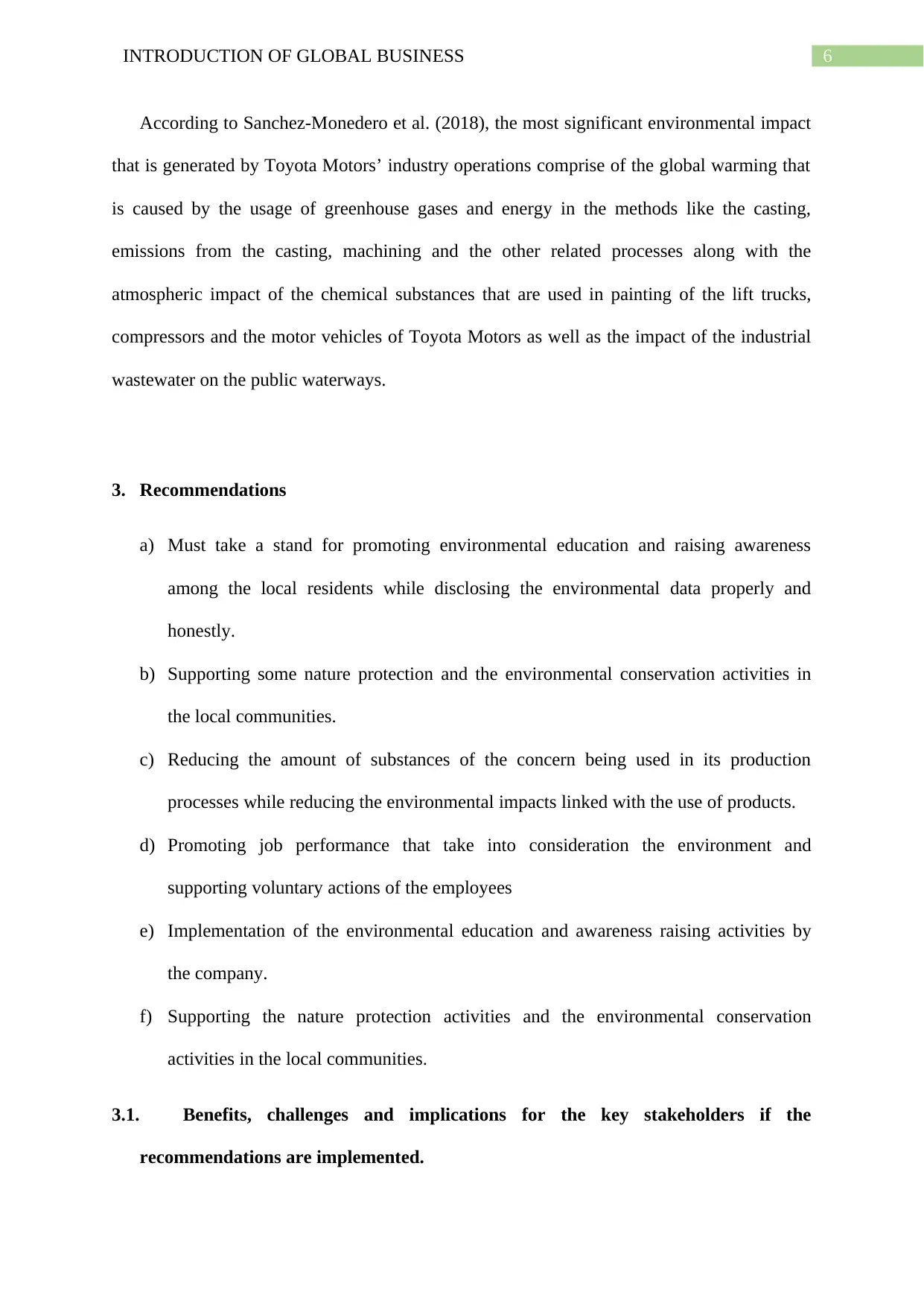
6INTRODUCTION OF GLOBAL BUSINESS
According to Sanchez-Monedero et al. (2018), the most significant environmental impact
that is generated by Toyota Motors’ industry operations comprise of the global warming that
is caused by the usage of greenhouse gases and energy in the methods like the casting,
emissions from the casting, machining and the other related processes along with the
atmospheric impact of the chemical substances that are used in painting of the lift trucks,
compressors and the motor vehicles of Toyota Motors as well as the impact of the industrial
wastewater on the public waterways.
3. Recommendations
a) Must take a stand for promoting environmental education and raising awareness
among the local residents while disclosing the environmental data properly and
honestly.
b) Supporting some nature protection and the environmental conservation activities in
the local communities.
c) Reducing the amount of substances of the concern being used in its production
processes while reducing the environmental impacts linked with the use of products.
d) Promoting job performance that take into consideration the environment and
supporting voluntary actions of the employees
e) Implementation of the environmental education and awareness raising activities by
the company.
f) Supporting the nature protection activities and the environmental conservation
activities in the local communities.
3.1. Benefits, challenges and implications for the key stakeholders if the
recommendations are implemented.
According to Sanchez-Monedero et al. (2018), the most significant environmental impact
that is generated by Toyota Motors’ industry operations comprise of the global warming that
is caused by the usage of greenhouse gases and energy in the methods like the casting,
emissions from the casting, machining and the other related processes along with the
atmospheric impact of the chemical substances that are used in painting of the lift trucks,
compressors and the motor vehicles of Toyota Motors as well as the impact of the industrial
wastewater on the public waterways.
3. Recommendations
a) Must take a stand for promoting environmental education and raising awareness
among the local residents while disclosing the environmental data properly and
honestly.
b) Supporting some nature protection and the environmental conservation activities in
the local communities.
c) Reducing the amount of substances of the concern being used in its production
processes while reducing the environmental impacts linked with the use of products.
d) Promoting job performance that take into consideration the environment and
supporting voluntary actions of the employees
e) Implementation of the environmental education and awareness raising activities by
the company.
f) Supporting the nature protection activities and the environmental conservation
activities in the local communities.
3.1. Benefits, challenges and implications for the key stakeholders if the
recommendations are implemented.
⊘ This is a preview!⊘
Do you want full access?
Subscribe today to unlock all pages.

Trusted by 1+ million students worldwide
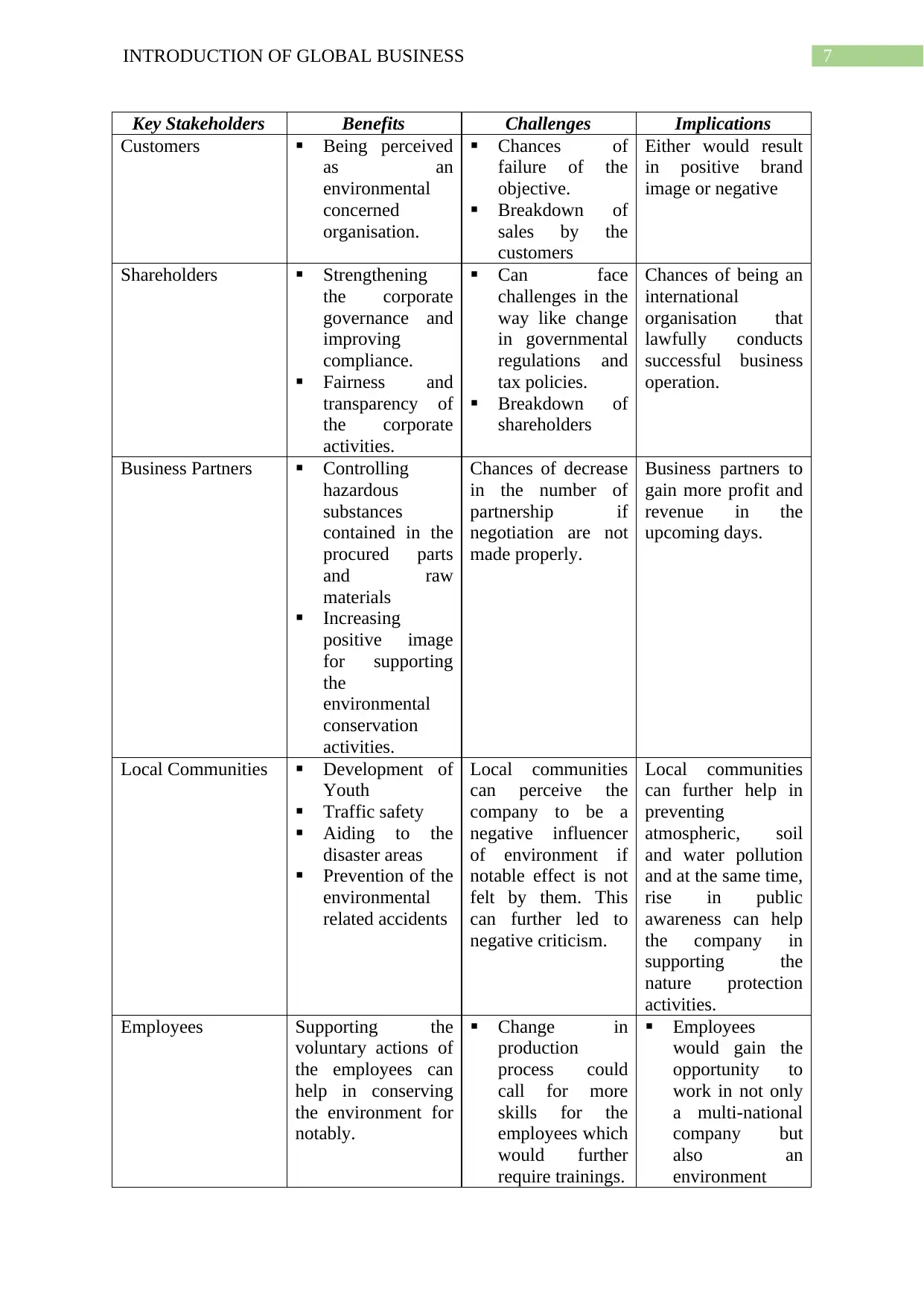
7INTRODUCTION OF GLOBAL BUSINESS
Key Stakeholders Benefits Challenges Implications
Customers Being perceived
as an
environmental
concerned
organisation.
Chances of
failure of the
objective.
Breakdown of
sales by the
customers
Either would result
in positive brand
image or negative
Shareholders Strengthening
the corporate
governance and
improving
compliance.
Fairness and
transparency of
the corporate
activities.
Can face
challenges in the
way like change
in governmental
regulations and
tax policies.
Breakdown of
shareholders
Chances of being an
international
organisation that
lawfully conducts
successful business
operation.
Business Partners Controlling
hazardous
substances
contained in the
procured parts
and raw
materials
Increasing
positive image
for supporting
the
environmental
conservation
activities.
Chances of decrease
in the number of
partnership if
negotiation are not
made properly.
Business partners to
gain more profit and
revenue in the
upcoming days.
Local Communities Development of
Youth
Traffic safety
Aiding to the
disaster areas
Prevention of the
environmental
related accidents
Local communities
can perceive the
company to be a
negative influencer
of environment if
notable effect is not
felt by them. This
can further led to
negative criticism.
Local communities
can further help in
preventing
atmospheric, soil
and water pollution
and at the same time,
rise in public
awareness can help
the company in
supporting the
nature protection
activities.
Employees Supporting the
voluntary actions of
the employees can
help in conserving
the environment for
notably.
Change in
production
process could
call for more
skills for the
employees which
would further
require trainings.
Employees
would gain the
opportunity to
work in not only
a multi-national
company but
also an
environment
Key Stakeholders Benefits Challenges Implications
Customers Being perceived
as an
environmental
concerned
organisation.
Chances of
failure of the
objective.
Breakdown of
sales by the
customers
Either would result
in positive brand
image or negative
Shareholders Strengthening
the corporate
governance and
improving
compliance.
Fairness and
transparency of
the corporate
activities.
Can face
challenges in the
way like change
in governmental
regulations and
tax policies.
Breakdown of
shareholders
Chances of being an
international
organisation that
lawfully conducts
successful business
operation.
Business Partners Controlling
hazardous
substances
contained in the
procured parts
and raw
materials
Increasing
positive image
for supporting
the
environmental
conservation
activities.
Chances of decrease
in the number of
partnership if
negotiation are not
made properly.
Business partners to
gain more profit and
revenue in the
upcoming days.
Local Communities Development of
Youth
Traffic safety
Aiding to the
disaster areas
Prevention of the
environmental
related accidents
Local communities
can perceive the
company to be a
negative influencer
of environment if
notable effect is not
felt by them. This
can further led to
negative criticism.
Local communities
can further help in
preventing
atmospheric, soil
and water pollution
and at the same time,
rise in public
awareness can help
the company in
supporting the
nature protection
activities.
Employees Supporting the
voluntary actions of
the employees can
help in conserving
the environment for
notably.
Change in
production
process could
call for more
skills for the
employees which
would further
require trainings.
Employees
would gain the
opportunity to
work in not only
a multi-national
company but
also an
environment
Paraphrase This Document
Need a fresh take? Get an instant paraphrase of this document with our AI Paraphraser
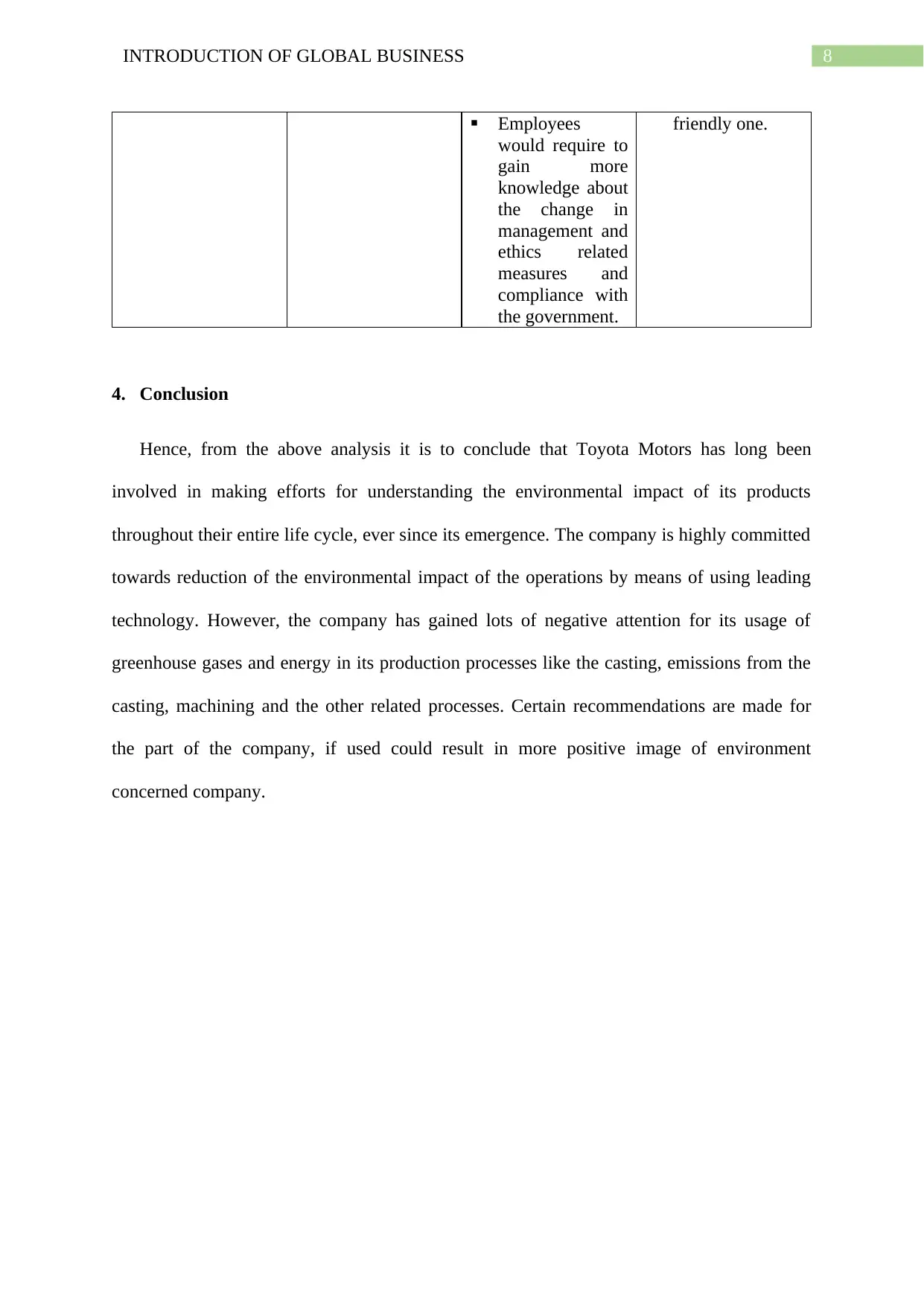
8INTRODUCTION OF GLOBAL BUSINESS
Employees
would require to
gain more
knowledge about
the change in
management and
ethics related
measures and
compliance with
the government.
friendly one.
4. Conclusion
Hence, from the above analysis it is to conclude that Toyota Motors has long been
involved in making efforts for understanding the environmental impact of its products
throughout their entire life cycle, ever since its emergence. The company is highly committed
towards reduction of the environmental impact of the operations by means of using leading
technology. However, the company has gained lots of negative attention for its usage of
greenhouse gases and energy in its production processes like the casting, emissions from the
casting, machining and the other related processes. Certain recommendations are made for
the part of the company, if used could result in more positive image of environment
concerned company.
Employees
would require to
gain more
knowledge about
the change in
management and
ethics related
measures and
compliance with
the government.
friendly one.
4. Conclusion
Hence, from the above analysis it is to conclude that Toyota Motors has long been
involved in making efforts for understanding the environmental impact of its products
throughout their entire life cycle, ever since its emergence. The company is highly committed
towards reduction of the environmental impact of the operations by means of using leading
technology. However, the company has gained lots of negative attention for its usage of
greenhouse gases and energy in its production processes like the casting, emissions from the
casting, machining and the other related processes. Certain recommendations are made for
the part of the company, if used could result in more positive image of environment
concerned company.

9INTRODUCTION OF GLOBAL BUSINESS
5. References:
Chen, Y., Tang, G., Jin, J., Li, J. and Paillé, P., 2015. Linking market orientation and
environmental performance: The influence of environmental strategy, employee’s
environmental involvement, and environmental product quality. Journal of Business
Ethics, 127(2), pp.479-500.
Cheng, Hong Ting, Ka Hong Cheong, Ching Ho Fok, Yuen Tung Li, Wing Yiu Sze, and
Wun Ching Wong. "Capital structure analysis of Toyota Motor Corporation." (2014).
Cui, P., Wu, S., Xiao, Y., Wan, M. and Cui, P., 2015. Inhibiting effect of Layered Double
Hydroxides on the emissions of volatile organic compounds from bituminous
materials. Journal of Cleaner Production, 108, pp.987-991.
Elnaga, Amir Abou, and Amen Imran. "The impact of employee empowerment on job
satisfaction: theoretical study." American Journal of Research Communication 2, no. 1
(2014): 13-26.
Guenther, A., Zimmerman, P. and Wildermuth, M., 2018. Natural volatile organic compound
emission rate estimates for US woodland landscapes. Atmospheric Environment, 28(6),
pp.1197-1210.
5. References:
Chen, Y., Tang, G., Jin, J., Li, J. and Paillé, P., 2015. Linking market orientation and
environmental performance: The influence of environmental strategy, employee’s
environmental involvement, and environmental product quality. Journal of Business
Ethics, 127(2), pp.479-500.
Cheng, Hong Ting, Ka Hong Cheong, Ching Ho Fok, Yuen Tung Li, Wing Yiu Sze, and
Wun Ching Wong. "Capital structure analysis of Toyota Motor Corporation." (2014).
Cui, P., Wu, S., Xiao, Y., Wan, M. and Cui, P., 2015. Inhibiting effect of Layered Double
Hydroxides on the emissions of volatile organic compounds from bituminous
materials. Journal of Cleaner Production, 108, pp.987-991.
Elnaga, Amir Abou, and Amen Imran. "The impact of employee empowerment on job
satisfaction: theoretical study." American Journal of Research Communication 2, no. 1
(2014): 13-26.
Guenther, A., Zimmerman, P. and Wildermuth, M., 2018. Natural volatile organic compound
emission rate estimates for US woodland landscapes. Atmospheric Environment, 28(6),
pp.1197-1210.
⊘ This is a preview!⊘
Do you want full access?
Subscribe today to unlock all pages.

Trusted by 1+ million students worldwide
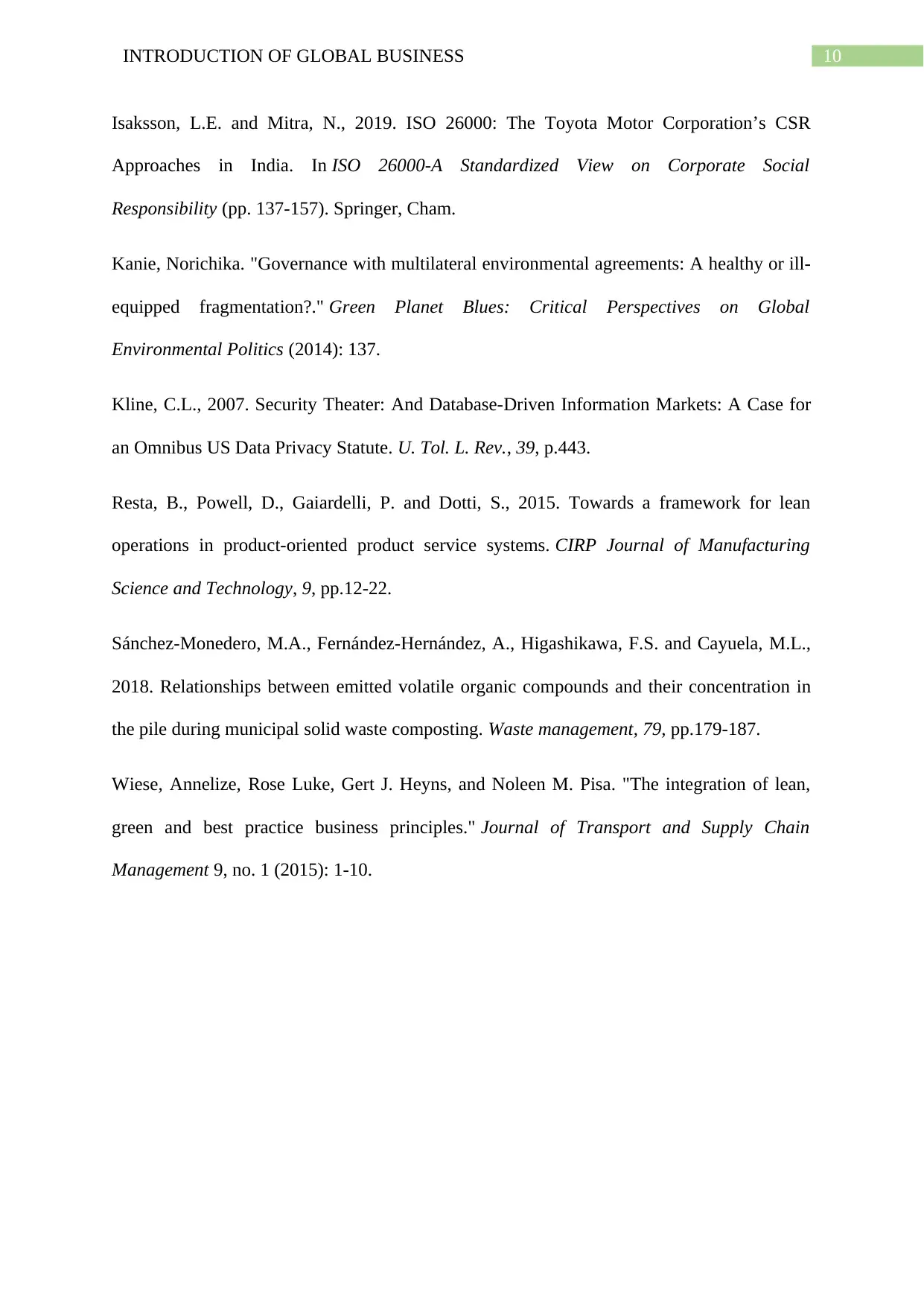
10INTRODUCTION OF GLOBAL BUSINESS
Isaksson, L.E. and Mitra, N., 2019. ISO 26000: The Toyota Motor Corporation’s CSR
Approaches in India. In ISO 26000-A Standardized View on Corporate Social
Responsibility (pp. 137-157). Springer, Cham.
Kanie, Norichika. "Governance with multilateral environmental agreements: A healthy or ill-
equipped fragmentation?." Green Planet Blues: Critical Perspectives on Global
Environmental Politics (2014): 137.
Kline, C.L., 2007. Security Theater: And Database-Driven Information Markets: A Case for
an Omnibus US Data Privacy Statute. U. Tol. L. Rev., 39, p.443.
Resta, B., Powell, D., Gaiardelli, P. and Dotti, S., 2015. Towards a framework for lean
operations in product-oriented product service systems. CIRP Journal of Manufacturing
Science and Technology, 9, pp.12-22.
Sánchez-Monedero, M.A., Fernández-Hernández, A., Higashikawa, F.S. and Cayuela, M.L.,
2018. Relationships between emitted volatile organic compounds and their concentration in
the pile during municipal solid waste composting. Waste management, 79, pp.179-187.
Wiese, Annelize, Rose Luke, Gert J. Heyns, and Noleen M. Pisa. "The integration of lean,
green and best practice business principles." Journal of Transport and Supply Chain
Management 9, no. 1 (2015): 1-10.
Isaksson, L.E. and Mitra, N., 2019. ISO 26000: The Toyota Motor Corporation’s CSR
Approaches in India. In ISO 26000-A Standardized View on Corporate Social
Responsibility (pp. 137-157). Springer, Cham.
Kanie, Norichika. "Governance with multilateral environmental agreements: A healthy or ill-
equipped fragmentation?." Green Planet Blues: Critical Perspectives on Global
Environmental Politics (2014): 137.
Kline, C.L., 2007. Security Theater: And Database-Driven Information Markets: A Case for
an Omnibus US Data Privacy Statute. U. Tol. L. Rev., 39, p.443.
Resta, B., Powell, D., Gaiardelli, P. and Dotti, S., 2015. Towards a framework for lean
operations in product-oriented product service systems. CIRP Journal of Manufacturing
Science and Technology, 9, pp.12-22.
Sánchez-Monedero, M.A., Fernández-Hernández, A., Higashikawa, F.S. and Cayuela, M.L.,
2018. Relationships between emitted volatile organic compounds and their concentration in
the pile during municipal solid waste composting. Waste management, 79, pp.179-187.
Wiese, Annelize, Rose Luke, Gert J. Heyns, and Noleen M. Pisa. "The integration of lean,
green and best practice business principles." Journal of Transport and Supply Chain
Management 9, no. 1 (2015): 1-10.
1 out of 10
Related Documents
Your All-in-One AI-Powered Toolkit for Academic Success.
+13062052269
info@desklib.com
Available 24*7 on WhatsApp / Email
![[object Object]](/_next/static/media/star-bottom.7253800d.svg)
Unlock your academic potential
Copyright © 2020–2025 A2Z Services. All Rights Reserved. Developed and managed by ZUCOL.





